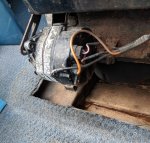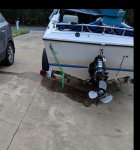I recently picked up a 1981 19ft stingray boat. 120HP Mercruiser I/O. Transom is solid, all original interior. No flex when on the water, no damage, just "normal wear and tear".
I have experience repairing boats and have a pretty good understanding of boats in general. I have been unable to find much about this boat, but it fires up, runs great. The deck is solid, other than a soft spot at the rear jump seat beside the motor cover, I lifted the deck and the stringer, from what I can see is solid.
I am not very much concerned with the condition of the boat, for a 38 year old boat, it is solid. I took it out 2 times this week (last on Tuesday) and today when I came home I noticed just a tiny bit of water in the bilge area, I discovered it running from the front area of the bilge, below where the motor mounts. I think it was possible a limber hole that was glassed over years ago during manufacturing, but I am not so sure. After jacking the front of the trailer up, a decent amount of water came out, I jabbed the hole with a screw driver and it is draining as I type this, not a lot, but steady. The good news is that it was already draining without being jacked up, on its own, I just lifted the front to help it along, this in only on one side.
I am concerned that water may be trapped below the deck/floor
 and a lot of rot may be imminent. Could anyone give me advice on how to drill an access if need be, or should I let it drain and not worry about it? I don't have any symptoms of major rot (stress cracks, flexing when hitting waves at speed, etc).
and a lot of rot may be imminent. Could anyone give me advice on how to drill an access if need be, or should I let it drain and not worry about it? I don't have any symptoms of major rot (stress cracks, flexing when hitting waves at speed, etc).
Attached are a few photos, so you can have an idea of what is going on.
I have experience repairing boats and have a pretty good understanding of boats in general. I have been unable to find much about this boat, but it fires up, runs great. The deck is solid, other than a soft spot at the rear jump seat beside the motor cover, I lifted the deck and the stringer, from what I can see is solid.
I am not very much concerned with the condition of the boat, for a 38 year old boat, it is solid. I took it out 2 times this week (last on Tuesday) and today when I came home I noticed just a tiny bit of water in the bilge area, I discovered it running from the front area of the bilge, below where the motor mounts. I think it was possible a limber hole that was glassed over years ago during manufacturing, but I am not so sure. After jacking the front of the trailer up, a decent amount of water came out, I jabbed the hole with a screw driver and it is draining as I type this, not a lot, but steady. The good news is that it was already draining without being jacked up, on its own, I just lifted the front to help it along, this in only on one side.
I am concerned that water may be trapped below the deck/floor

 and a lot of rot may be imminent. Could anyone give me advice on how to drill an access if need be, or should I let it drain and not worry about it? I don't have any symptoms of major rot (stress cracks, flexing when hitting waves at speed, etc).
and a lot of rot may be imminent. Could anyone give me advice on how to drill an access if need be, or should I let it drain and not worry about it? I don't have any symptoms of major rot (stress cracks, flexing when hitting waves at speed, etc).Attached are a few photos, so you can have an idea of what is going on.



















